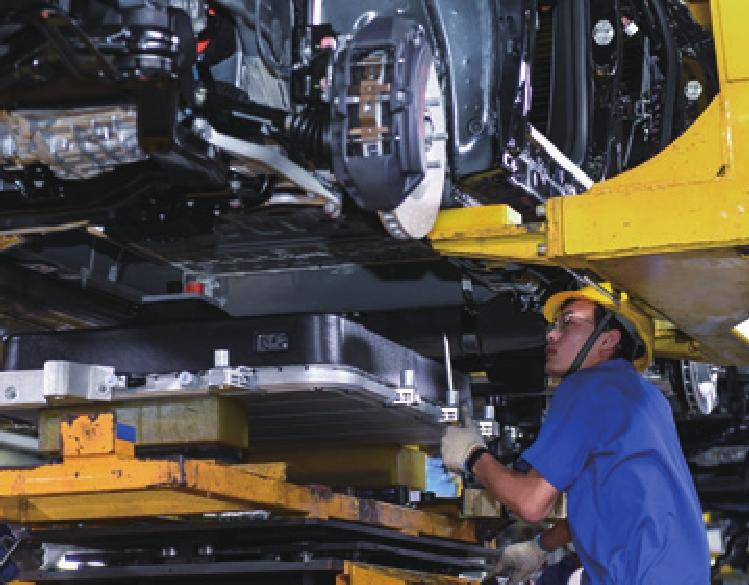Urban Without Carbon
By Wang Jun
S&P Global Market Intelligence is anticipating an upsurge in green bonds from China, which was already the third largest issuer of the bonds in the fi rst half of the year, following the U.S. and France. Its report on October 12 showed market analysts thinking in that vein.
“I believe China will continue to boost investment in environmentally friendly and infrastructure projects,” Arthur Lau, head of Asia excluding Japan fi xed income at New Yorkbased PineBridge Investments, told the agency.“Hence, I would expect some of these investments will be funded through the new issuance of green bonds.”
The expectations are coming fast and furious after President Xi Jinping announced at the General Debate of the 75th Session of the United Nations General Assembly in September that China will achieve carbon neutrality—net zero carbon emission—before 2060.

“China will scale up its intended nationally determined contributions by adopting more vigorous policies and measures. We aim to have carbon dioxide emissions peak before 2030 and achieve carbon neutrality before 2060,” Xi said, the fi rst time China announced to the world its timetable for achieving a carbon-free state.
Carbon neutrality refers to achieving net zero greenhouse gas emission by balancing carbon dioxide emissions with carbon removal or eliminating emissions altogether.
Energy sector revamp
Xis announcement has put the power sector squarely in the limelight. Coal-fired plants produce over 50 percent of electricity and cause the most pollution. For carbon neutrality, investment has to be upped in nuclear, hydro, wind and solar power and other forms of clean renewable energy.
In the national energy plan for 2016-20, coal consumption in the energy mix is expected to fall to 58 percent by end-2020 from 64 percent at the end of 2015. The share of renewable energy sources will rise to 39 percent from 35 percent. Carbon emission per unit of GDP is also targeted to be reduced by 18 percent. An updated energy plan for 2021-25 will be released next year.
From peaking emissions in 2030 to achieving a net zero carbon footprint by 2060, China needs to get rid of the over 10 billion tons of net carbon emissions it produces annually. According to Wang Lining, chief engineer with the market research department of CNPC Economics and Technology Research Institute, that would require reducing 300-350 million tons a year.
He told 21st Century Business Herald in the current energy mix, fossil fuels account for more than 80 percent of the energy consump-tion, with coal accounting for as much as 55 percent. “To achieve carbon neutrality, the proportion of fossil fuels (coal, oil and natural gas) must be less than 30 percent in the energy mix in 2060, with natural gas accounting for the highest proportion,” he added.
Zhang Lei, chief executive offi cer of green technology fi rm Envision Group, sees the target ushering in accelerated development of the renewable energy industry. In the 40 years to come, the average annual installed capacity of renewable energy will be more than 200 million kilowatts.
“What is needed next is a more concrete roadmap,” he told 21st Century Business Herald.
Roadmap to energy revolution
It will be a short road, according to He Jiankun, Deputy Director of the National Expert Committee on Climate Change. At a Ministry of Ecology and Environment (MEE) policy briefi ng last month, he said while developed countries have 60 to 70 years from peaking carbon emissions to leaving no carbon footprint, China will have only 30 years to complete the process.
“Therefore China must transform its energy mix and reduce emissions of greenhouse gases much faster and more intensively,” he said.

He outlined a four-way path to achieve the goal: increasing the intensity of industrial restructuring and advancing low carbon consumption through digitalization; saving resources and developing a circular economy; preparing for energy substitution and building an energy system with near-zero emissions; seeking nature-based solutions in agriculture, forestry, grassland and wetland to ensure an annual absorption of 800 million tons of carbon dioxide.
The Institute of Energy, Environment and Economy at Tsinghua University in Beijing has already come up with a roadmap. It forecasts carbon emissions would peak between 2025 and 2030, energy demand begin to decline around 2035, and a rapid transition after 2035. Coal-fi red plants would be phased out by 2050, by which the energy mix would have seen a sea change.
On the face of it, the ambitious plan is aimed at reducing carbon emission. But according to Li Gao, Director of the Department of Climate Change at MEE, it is a major driving force for Chinas high-quality development and overall economic and social progress.
“China must signifi cantly reduce its carbon dioxide emissions, which will force constant re- adjustment and improvement of its energy mix and industrial structure, stimulating powerful growth of green industries,” he said. To reach the peak of carbon emission at an early date while maintaining sustained economic growth, the readjustment of the energy mix must be given top priority. Li pointed out that the cost of photovoltaic power has fallen by 90 percent in the past decade, creating a competitive advantage in price over thermal power.
Xu Huaqing, head of the National Center for Climate Change Strategy and International Cooperation, said at the MEE briefing that the target will promote the transformation of the energy mix, upgrade the industrial structure and create multiple synergies in economic competitiveness, social development and environmental protection.
The 14th Five-Year Plan (2021-25) will not only set energy consumption targets but also make better use of market tools as well as policies on science and technology, fiscal and taxation and environmental protection to promote high-quality development.
The renewable energy industry has created almost as many jobs as the traditional coal industry has. This means the impact on traditional industries can be offset by the growth of emerging industries. “In the future, renewable energy and related industries will create more and better job opportunities,” Li said.
Where it all began
At the 2015 United Nations Climate Change Conference held in Paris, China committed to peaking carbon dioxide emissions by 2030 and expected rapid reduction after that. It also vowed to cut its carbon emissions per unit of GDP by 60-65 percent from 2005 levels by 2030.
Since then, China has promoted ecological progress in the 13th Five-Year Plan (2016-20) and in 2018, the Constitution was amended to add protection of the environment to the duties of the State Council, which included building an ecological civilization. Vigorously developing clean energy and advancing energy transformation have become Chinas long-term strategy.
Carbon neutrality in China means more than a clean environment for the Chinese. It is a step in the global action needed to combat the fallouts of climate change.
“Especially in recent two years, extreme weather events have occurred more frequently across the world,” Wang said. “Climate change has become a common challenge faced by people all over the world. So it needs to be solved through global solidarity.”

